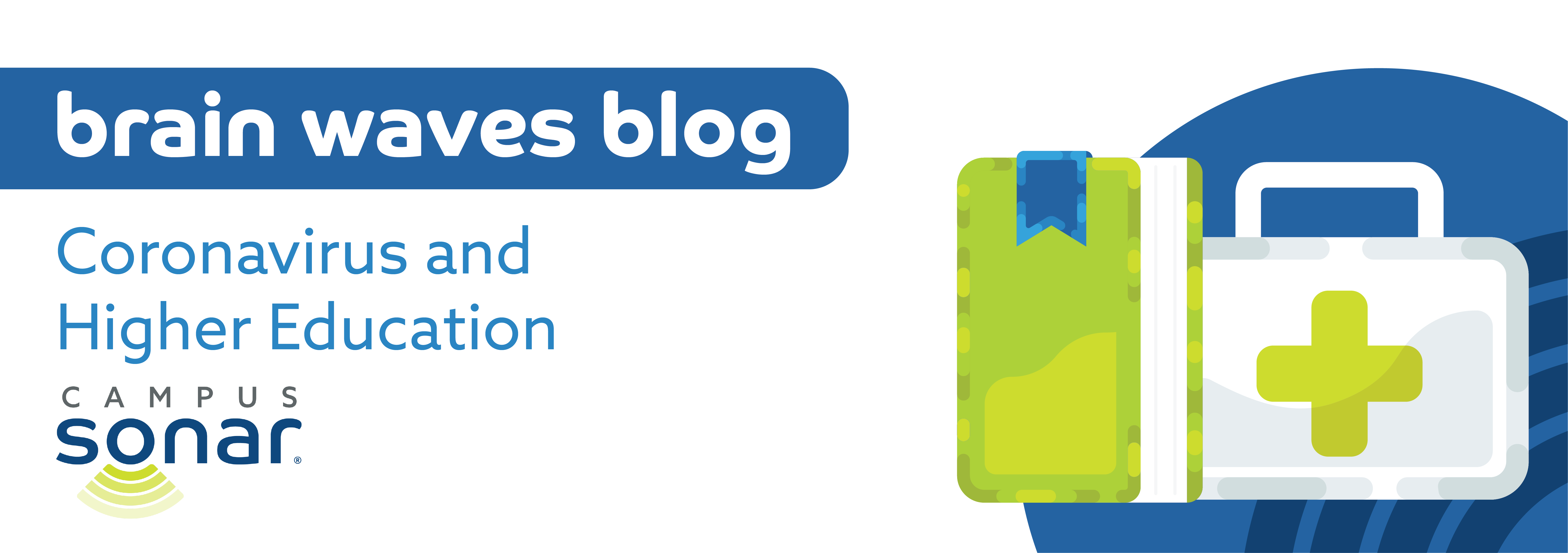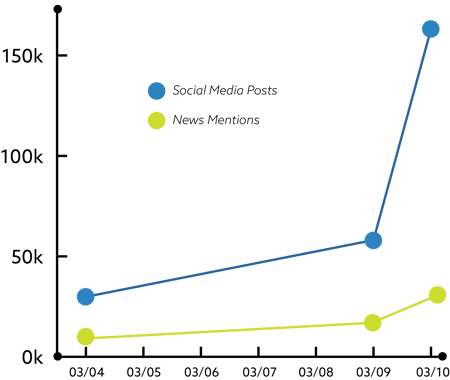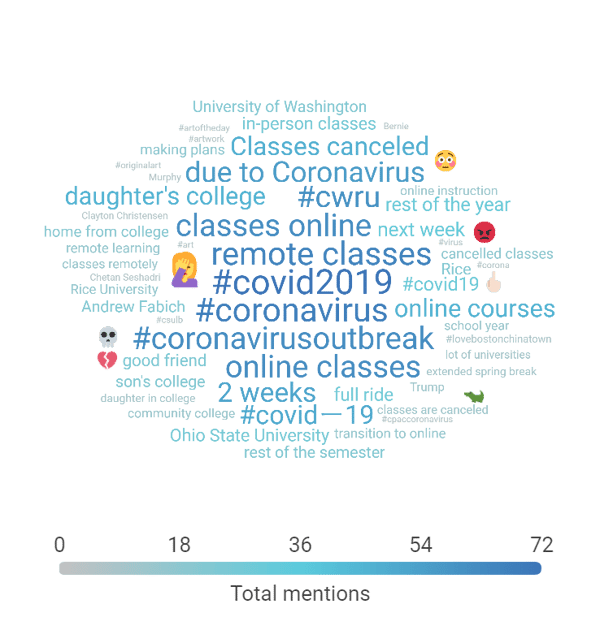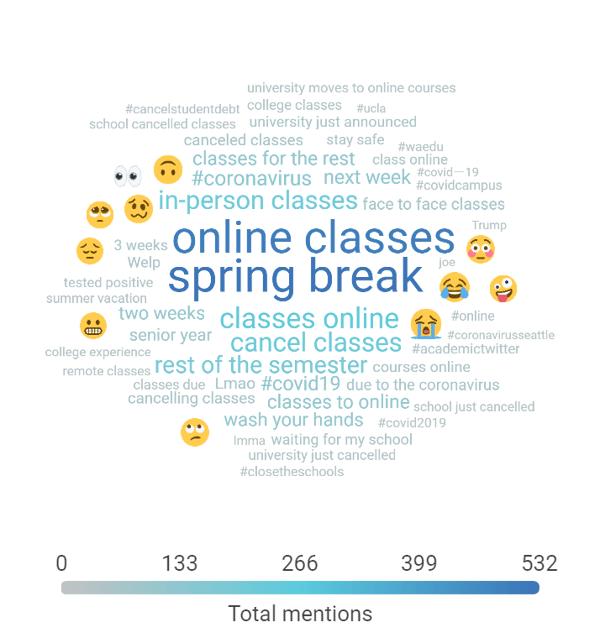Coronavirus Higher Education Industry Briefing: March 11

As campuses and their constituents grapple with the implications of closures, extended-spring breaks, and online instruction to mitigate the coronavirus pandemic, online conversation on the topic is ballooning. We wanted to see the amount of conversation, find patterns, and develop insights to help campuses with their communication strategy. Yesterday (March 10), we gathered all of the online conversation about the coronavirus, higher education, related closures, and transitions to online coursework. Today, we analyzed it. Here’s what we found.
Conversation Is Growing Exponentially
Not unlike the virus itself, conversation about COVID-19 is growing exponentially. Higher education was mentioned in at least half a million online conversations about the virus since January.
The last week of February, conversation volume doubled in comparison to earlier weeks. It doubled again the first week in March, and grew by a factor of four on March 10, as dozens of campuses announced changes to their operations.
Volume is increasing on an hourly basis, even as I write this. We certainly haven’t hit the peak of coronavirus higher education conversation.
Campuses are often mentioned as an incidental part of a local news story—discussing the impact of the coronavirus in a metro area with a mention of campuses that closed. About a third of the time, a campus is the focus of the mention about the coronavirus (i.e., a headline of a news article or mentioned in a social media post). This ratio actually hasn’t changed much over the last week, although the volume is increasing.
It may feel like people are talking about your campus and coronavirus more often—because they are—but they’re also talking about other institutions (e.g., government agencies, politicians, healthcare, private business). Higher education is not always the center of the story.
Social Media Is Taking Over
News items that mentioned higher education and the coronavirus were fairly consistent for the last week—about 10,000–15,000 stories per day. Social media was fairly consistent as well with about 25,000–30,000 posts. That balance changed on Monday, March 9. Social media posts surged to over 58,000 while news mentions stayed under 16,000. On Tuesday, March 10, social media nearly tripled to over 163,000 mentions, while news mentions increased moderately to about 23,000. The narrative about coronavirus and higher education is now predominantly driven by social media conversation, rather than journalists.
 Other interesting sources of coronavirus conversation that may not be on your radar include Tumblr (tens of thousands of mentions in the last seven days) and forums. We often mean Reddit when we talk about forum conversation and, while there is coronavirus conversation on Reddit, it’s also happening on many other sites, such as campus-specific forums and niche communities like MyFitnessPal or Educause.
Other interesting sources of coronavirus conversation that may not be on your radar include Tumblr (tens of thousands of mentions in the last seven days) and forums. We often mean Reddit when we talk about forum conversation and, while there is coronavirus conversation on Reddit, it’s also happening on many other sites, such as campus-specific forums and niche communities like MyFitnessPal or Educause.
Individual Voices Provide Insights to Guide Messaging
Because of all the news coverage and amplification, it’s hard to find the individual voices in the conversation. While over 100,000 individual accounts are contributing to conversation specifically about higher education and the coronavirus, less than 5 percent of the mentions are first-person accounts from individuals who reveal an affiliation with a campus. These hidden voices represent lived experiences that provide valuable insight as you craft your communication and service delivery.
We identified five audiences talking about this issue: students, family and friends, alumni, prospective students, and admitted students. Most of the mentions (79 percent) were from students; family and friends contributed 16.6 percent of mentions. The majority of conversations are happening on Twitter and Tumblr, but prospective students are more likely to talk about the issue on forums.
Just looking at topic clouds, you can see how the words, phrases, hashtags, and emojis differ between the family and friends word cloud compared to the students word cloud.
Family and Friends Word Cloud

Students Word Cloud
 Students are nervous and anxious about online courses, especially lab and performance classes or experiential learning like student teaching or clinicals. They’re also concerned about closures affecting their ability to graduate on time. Some (not the majority) are excited they don’t have to go to class anymore—we’ll see how that sentiment holds up over time.
Students are nervous and anxious about online courses, especially lab and performance classes or experiential learning like student teaching or clinicals. They’re also concerned about closures affecting their ability to graduate on time. Some (not the majority) are excited they don’t have to go to class anymore—we’ll see how that sentiment holds up over time.
Family and friends display emotions that demonstrate empathy for their students. Some are heartbroken their students will miss out on the spring of their senior year, or a study abroad opportunity. Others are angry the coronavirus has interrupted their planned college visits with their high school students.
Alumni aren’t a large part of this group. When they refer to their alma mater, they’re commenting on the actions taken to stop the spread of the virus and are generally positive or neutral.
Prospective student voices are harder to find (and potentially less frequent). What we found indicated they are wondering if admissions decisions will be delayed, or if institutions will change their admissions criteria. A general tone of anxiety is present, which we learned in our social listening study of college admissions isn’t unusual.
How Social Listening Insights Inform Coronavirus Communications
- Online conversation about the coronavirus and higher education is increasing; we’ve not yet hit the peak. If it feels tough to keep up with now, it’s likely to get more hectic. Prepare now.
- The largest online conversation increase is on social media. Make sure leadership includes your social media managers in communication strategy meetings and provides them with talking points. Meg Bernier Keniston, Director of Marketing and Content Strategy at St. Lawrence University, shares great advice to integrate social media into your coronavirus communication strategy. Make a plan for ongoing coverage of social media channels rather than asking one or two staff members to work non-stop for weeks.
- If you’re interested in student voices, pay attention to Tumblr in addition to Twitter, Facebook, and Instagram. 20 percent of the student conversation we found was on Tumblr.
- Recognize that students are anxious and nervous. They don’t just want information; they want support and reassurance. Currently, they’re anxious about how online classes will work, particularly for non-lecture format courses.
- Family and friends are heartbroken thinking about the experiences their students are losing. If you’re working to develop effective distance or small-group programming, make sure that’s communicated to parents.
- Prospective students have high levels of anxiety, and their parents may be frustrated with limited visit opportunities. Consider ways you can effectively communicate the alternative options you’re offering to prospective and admitted students.
We Want To Know How You Use This
We’ve never released a timely briefing like this. If you find it valuable, please let us know (tweet us at @CampusSonar, email info@campussonar.com, or comment on this post). As a former university housing employee and campus marketing and communication director, I have an inkling of how you’re feeling right now. Take a break when you can, and don’t forget to take care of yourself as you take care of your campus community. The Sonarians are rooting for you.

